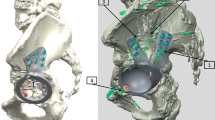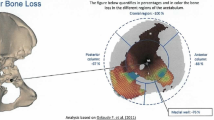Abstract
Purpose
Acetabular revision of failed total hip arthroplasty (THA) is often associated with severe bone loss. Therefore, a variety of revision implant systems has been developed during recent years, with the augment-and-modular-cage system being one of the newest additions to this portfolio. Together with biologic downsizing by means of impaction bone grafting, this uncemented system promises a high modularity and versatility to treat all acetabular defects up to Paprosky types IIIa and IIIb without pelvic discontinuity. The aim of the present study was to evaluate first short-term results of its clinical application, both clinical functional and patient-reported as well as radiographic.
Methods
Forty-four patients (28 female, 16 male, mean age 70.9 ± 11.5 years) could be followed for a mean of 26 ± 10 months after acetabular revision with a novel augment-and-modular-cage system. Indications for revision included aseptic loosening (68%), septic loosening (16%), or others (16%) with bone loss Paprosky IIa up to IIIb without discontinuity. The modified Harris Hip Score (mHHS) served as a primary outcome parameter. In addition, a number of patient-reported outcome measurements (PROMs) were collected including the Short Form 36 (SF-36), Hip disability and Osteoarthritis Outcome Score (HOOS), and Visual Analogue Scale for Hip Pain (VAS Hip) as well as overall satisfaction. Radiographic changes between the pre- and postoperative center of rotation (COR) and various criteria of implant failure served as secondary outcome parameters.
Results
No patients were lost to follow-up. Two implant-associated complications (partial flange breakage) without a need for revision surgery were detected, which represent a failure rate of 4.5%. Functional outcome as measured by mHHS increased from 49.4 ± 2.9 pre-operatively to 74.4 ± 3.1 at the latest follow-up (p < 0.001). PROMs showed significant improvements in all pain-related categories, while other quality-of-life measurements only exhibited positive tendencies towards improvement. VAS Hip significantly improved from 6.5 ± 0.7 pre-operatively to 2.2 ± 0.6 at the latest follow-up (p < 0.001). Radiographic evaluation showed that reconstruction of the COR was possible, referenced to the contralateral side. The COR could be lateralized by 5.0 mm (n.s.) and caudalized by 10.3 mm (p < 0.001) comparing pre-operative and post-operative states, with complete osseointegration in 95% of the cases.
Conclusions
Treatment with the augment-and-modular-cage system significantly improved clinical functional and patient-reported outcomes in cases of acetabular revision after failed THA. In addition, a good reconstruction of the COR could also be achieved. Therefore, this highly modular system can be considered as an effective treatment option in almost all cases of acetabular bone loss except for those of pelvic discontinuity. It offers the unique possibility of intra-operative implant customization according to the existing bone defect and host bone quality.





Similar content being viewed by others
References
Labek G, Thaler M, Janda W et al (2011) Revision rates after total joint replacement: cumulative results from worldwide joint register datasets. J Bone Joint Surg Br 93:293–297. https://doi.org/10.1302/0301-620X.93B3.25467
Paprosky WG, Sporer SS, Murphy BP (2007) Addressing severe bone deficiency: what a cage will not do. J Arthroplasty 22:111–115. https://doi.org/10.1016/j.arth.2007.01.018
Mall NA, Nunley RM, Smith KE et al (2010) The fate of grafting acetabular defects during revision total hip arthroplasty. Clin Orthop Relat Res 468:3286–3294. https://doi.org/10.1007/s11999-010-1427-0
Sadri H, Pfander G, Siebenrock K-A et al (2008) Acetabular reinforcement ring in primary total hip arthroplasty: a minimum 10-year follow-up. Arch Orthop Trauma Surg 128:869–877. https://doi.org/10.1007/s00402-008-0612-z
García-Rey E, Cruz-Pardos A, Madero R (2015) The evolution of the technique of impaction bone grafting in femoral revision surgery has improved clinical outcome. A prospective mid-term study. J Arthroplast 30:95–100. https://doi.org/10.1016/j.arth.2014.08.028
Kosashvili Y, Backstein D, Safir O et al (2009) Acetabular revision using an anti-protrusion (ilio-ischial) cage and trabecular metal acetabular component for severe acetabular bone loss associated with pelvic discontinuity. J Bone Joint Surg Br 91:870–876. https://doi.org/10.1302/0301-620X.91B7.22181
Beckmann NA, Bitsch RG, Gondan M et al (2018) Comparison of the stability of three fixation techniques between porous metal acetabular components and augments. Bone Joint Res 7:282–288. https://doi.org/10.1302/2046-3758.74.BJR-2017-0198.R1
Krishnan KM, Longstaff L, Partington P (2011) Acetabular reconstruction using morcellised bone with ring support—medium-term results at three to nine years. Acta Orthop Belg 77:61–67
Schmolders J, Friedrich MJ, Michel RD et al (2015) Acetabular defect reconstruction in revision hip arthroplasty with a modular revision system and biological defect augmentation. Int Orthop 39:623–630. https://doi.org/10.1007/s00264-014-2533-5
Günther KP, Wegner T, Kirschner S, Hartmann A (2014) Modular reconstruction in acetabular revision with antiprotrusio cages and metal augments: the cage-and-augment system. Oper Orthop Traumatol 26:141–155. https://doi.org/10.1007/s00064-013-0271-2
Charlson ME, Pompei P, Ales KL, MacKenzie CR (1987) A new method of classifying prognostic comorbidity in longitudinal studies: development and validation. J Chronic Dis 40:373–383
Charnley J (1972) The long-term results of low-friction arthroplasty of the hip performed as a primary intervention. J Bone Joint Surg Br 54:61–76
Marx A, Beier A, Richter A et al (2016) Major acetabular defects treated with the Burch-Schneider antiprotrusion cage and impaction bone allograft in a large series: a 5- to 7- year follow-up study. Hip Int 26:585–590. https://doi.org/10.5301/hipint.5000388
Ilyas I, Alrumaih HA, Kashif S et al (2015) Revision of type III and type IVB acetabular defects with Burch-Schneider anti-Protrusio cages. J Arthroplast 30:259–264. https://doi.org/10.1016/j.arth.2014.08.014
Cucchi D, Gathen M, Streicher R, Wirtz DC (2018) Ceramic-on-ceramic in total hip replacement revision. Z Orthop Unfall 156:272–280. https://doi.org/10.1055/s-0043-124767
Wirtz DC, Wacker M, Jaenisch M, Roessler PP (2018) Acetabular revision arthroplasty with a novel cementless “augment-and-modular-cage” system (MRS-C): surgical technique and first clinical results. Oper Orthop Traumatol:1–10
Paprosky WG, Perona PG, Lawrence JM (1994) Acetabular defect classification and surgical reconstruction in revision arthroplasty. A 6-year follow-up evaluation. J Arthroplast 9:33–44
Desbonnet P, Connes H, Escare P et al (2012) Total hip revision using a cup design with a peg to treat severe pelvic bone defects. Orthop Traumatol Surg Res 98:346–351. https://doi.org/10.1016/j.otsr.2012.01.006
Lietman SA, Bhavnani K (2001) The partial pelvic replacement cup in severe acetabular defects. Orthopedics 24:1131–1135
Söderman P, Malchau H (2001) Is the Harris hip score system useful to study the outcome of total hip replacement? Clin Orthop Relat Res:189–197
Brazier JE, Harper R, Jones NM et al (1992) Validating the SF-36 health survey questionnaire: new outcome measure for primary care. BMJ 305:160–164
Nilsdotter AK, Lohmander LS, Klässbo M, Roos EM (2003) Hip disability and osteoarthritis outcome score (HOOS)—validity and responsiveness in total hip replacement. BMC Musculoskelet Disord 4:10. https://doi.org/10.1186/1471-2474-4-10
Brokelman RBG, Haverkamp D, van Loon C et al (2012) The validation of the visual analogue scale for patient satisfaction after total hip arthroplasty. Eur Orthop Traumatol 3:101–105. https://doi.org/10.1007/s12570-012-0100-3
DeLee JG, Charnley J (1976) Radiological demarcation of cemented sockets in total hip replacement. Clin Orthop Relat Res:20–32
Brooker AF, Bowerman JW, Robinson RA, Riley LH (1973) Ectopic ossification following total hip replacement. Incidence and a method of classification. J Bone Joint Surg Am 55:1629–1632
Bonnomet F, Vanhille W, Lefèbvre Y et al (2001) Failure of acetabular cups fixed with cement and thick embedded wire mesh. Rev Chir Orthop Reparatrice Appar Mot 87:544–555
Sculco PK, Ledford CK, Hanssen AD et al (2017) The evolution of the cup-cage technique for major acetabular defects: full and half cup-cage reconstruction. J Bone Joint Surg Am 99:1104–1110. https://doi.org/10.2106/JBJS.16.00821
Friedrich MJ, Schmolders J, Michel RD et al (2014) Management of severe periacetabular bone loss combined with pelvic discontinuity in revision hip arthroplasty. Int Orthop 38:2455–2461. https://doi.org/10.1007/s00264-014-2443-6
Fink B, Grossmann A, Sebena P (2010) Exchange of acetabular cups with severe bone defects using antiprotrusion cages. Oper Orthop Traumatol 22:256–267. https://doi.org/10.1007/s00064-010-8025-x
Mahmoud AN, Sundberg M, Flivik G (2017) Comparable results with porous metal augments in combination with either cemented or uncemented cups in revision hip arthroplasty: an analysis of one hundred forty-seven revisions at a mean of five years. J Arthroplast 32:1612–1617. https://doi.org/10.1016/j.arth.2016.12.007
Schmolders J, Amvrazis G, Pennekamp PH et al (2017) Thirteen-year follow-up of a cementless femoral stem and a threaded acetabular cup in patients younger than fifty years of age. Int Orthop 41:39–45. https://doi.org/10.1007/s00264-016-3226-z
Jauregui JJ, Banerjee S, Cherian JJ et al (2015) Early outcomes of titanium-based highly-porous acetabular components in revision total hip arthroplasty. J Arthroplast 30:1187–1190. https://doi.org/10.1016/j.arth.2015.02.013
Borland WS, Bhattacharya R, Holland JP, Brewster NT (2012) Use of porous trabecular metal augments with impaction bone grafting in management of acetabular bone loss. Acta Orthop 83:347–352. https://doi.org/10.3109/17453674.2012.718518
Lieberman JR, Dorey F, Shekelle P et al (1997) Outcome after total hip arthroplasty. Comparison of a traditional disease-specific and a quality-of-life measurement of outcome. J Arthroplast 12:639–645
Berry DJ (2004) Antiprotrusio cages for acetabular revision. Clin Orthop Relat Res:106–112
Gerber A, Pisan M, Zurakowski D, Isler B (2003) Ganz reinforcement ring for reconstruction of acetabular defects in revision total hip arthroplasty. J Bone Joint Surg Am 85-A:2358–2364
Author information
Authors and Affiliations
Corresponding author
Ethics declarations
Conflict of interest
The authors declare that they have no conflict of interest.
Ethical approval
All procedures performed in this study were in accordance with the ethical standards of the institutional and national research committee and with the 1964 Helsinki declaration and its later amendments or comparable ethical standards. For this type of study, formal consent is not required. All data obtained is part of in-house quality assessment in accordance with National Register procedures. Additional approval for this study was obtained from the institutional review board of our hospital (study no. 369/17).
Rights and permissions
About this article
Cite this article
Roessler, P.P., Jaenisch, M., Kuhlmann, M. et al. The augment-and-modular-cage revision system for reconstruction of severe acetabular defects—two-year clinical and radiographic results. International Orthopaedics (SICOT) 43, 2269–2278 (2019). https://doi.org/10.1007/s00264-018-4271-6
Received:
Accepted:
Published:
Issue Date:
DOI: https://doi.org/10.1007/s00264-018-4271-6




